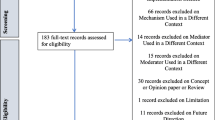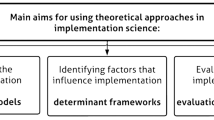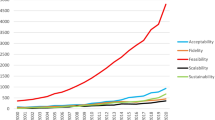Abstract
Purpose of Review
We review recent implementation science focusing on eHealth interventions to improve outcomes along the HIV care cascade. We highlight several gaps in the eHealth implementation literature and propose areas for future study.
Recent Findings
We identified 17 studies conducted in North America, Europe, and sub-Saharan Africa assessing the acceptability, appropriateness, adoption, cost, feasibility, fidelity, penetration, or sustainability of eHealth interventions targeting the HIV care cascade. Most interventions used SMS messages to improve cascade outcomes. Feasibility research has demonstrated the importance of adaptability for intervention scale-up and delivery. Key gaps in the literature remain related to predictors of the adoption of eHealth interventions by health facilities and staff. In addition, no studies explored sustainability and few used theoretical frameworks for implementation research or validated measures of implementation outcomes. We propose next steps for the future of eHealth implementation research to inform the delivery, scale-up, and maintenance of eHealth interventions in the real world.
Similar content being viewed by others
References
Papers of particular interest, published recently, have been highlighted as: • Of importance •• Of major importance
World Bank. Information Communication Technologies ai. Information and communications for development. Maximizing mobile. World Bank Publications. 2012;2012
eMarketer. Mobile phone internet user penetration worldwide from 2014 to 2019: Statistica- The Statistica Portal2018.
eMarketer. Smartphone user penetration as percentage of total global population from 2011 to 2018. Statistica - The Statistics Portal 2014. http://www.statista.com/statistics/203734/global-smartphone-penetration-per-capita-since-2005/. Accessed Feb 11 2018.
Akhlaq A, McKinstry B, Muhammad KB, Sheikh A. Barriers and facilitators to health information exchange in low-and middle-income country settings: a systematic review. Health Policy Plan. 2016;31(9):1310–25.
Henny KD, Wilkes AL, McDonald CM, Denson DJ, Neumann MS. A rapid review of eHealth interventions addressing the continuum of HIV care. AIDS Behav. 2007–2017;2018:1–21.
Mills EJ, Lester R, Thorlund K, Lorenzi M, Muldoon K, Kanters S, et al. Interventions to promote adherence to antiretroviral therapy in Africa: a network meta-analysis. The Lancet HIV. 2014;1(3):e104–e11.
World Health Organization. Consolidated guidelines on the use of antiretroviral drugs for treating and preventing HIV infection: recommendations for a public health approach. World Health Organization; 2016.
White A, Thomas DS, Ezeanochie N, Bull S. Health worker mHealth utilization: a systematic review. Computers, informatics, nursing: CIN. 2016;34(5):206.
Simoni JM, Aunon FM, Kemp CG, Kutner BA, Ramaiya MK, Velloza J, et al. Implementation research on HIV adherence interventions: no time to wait. Lancet Infect Dis. 2017;17(6):564–5.
Tomlinson M, Rotheram-Borus MJ, Swartz L, Tsai AC. Scaling up mHealth: where is the evidence? PLoS Med. 2013;10(2):e1001382.
Chen L, Evans T, Anand S, Boufford JI, Brown H, Chowdhury M, et al. Human resources for health: overcoming the crisis. Lancet. 2004;364(9449):1984–90.
Mechael P, Batavia H, Kaonga N, Searle S, Kwan A, Goldberger A et al. Barriers and gaps affecting mHealth in low and middle income countries: Policy white paper. Columbia university. Earth institute. Center for global health and economic development (CGHED): with mHealth alliance; 2010.
Odeny TA, Padian N, Doherty MC, Baral S, Beyrer C, Ford N, et al. Definitions of implementation science in HIV/AIDS. The Lancet HIV. 2015;2(5):e178–e80.
Means AR, Phillips DE, Lurton G, Njoroge A, Furere SM, Liu R, et al. The role of implementation science training in global health: from the perspective of graduates of the field’s first dedicated doctoral program. Glob Health Action. 2016;9:31899.
Proctor EK, Powell BJ, McMillen JC. Implementation strategies: recommendations for specifying and reporting. Implement Sci. 2013;8(1):139.
Powell BJ, Waltz TJ, Chinman MJ, Damschroder LJ, Smith JL, Matthieu MM, et al. A refined compilation of implementation strategies: results from the expert recommendations for implementing change (ERIC) project. Implement Sci. 2015;10(1):21.
Proctor E, Silmere H, Raghavan R, Hovmand P, Aarons G, Bunger A, et al. Outcomes for implementation research: conceptual distinctions, measurement challenges, and research agenda. Admin Pol Ment Health. 2011;38(2):65–76. https://doi.org/10.1007/s10488-010-0319-7.
Tetroe J. Knowledge translation at the Canadian Institutes of Health Research: a primer. Focus Technical Brief. 2007;18:1–8.
Damschroder LJ, Aron DC, Keith RE, Kirsh SR, Alexander JA, Lowery JC. Fostering implementation of health services research findings into practice: a consolidated framework for advancing implementation science. Implement Sci. 2009;4(1):50.
Glasgow RE, Vogt TM, Boles SM. Evaluating the public health impact of health promotion interventions: the RE-AIM framework. Am J Public Health. 1999;89(9):1322–7.
Nilsen P. Making sense of implementation theories, models and frameworks. Implement Sci. 2015;10(1):53.
Curran GM, Bauer M, Mittman B, Pyne JM, Stetler C. Effectiveness-implementation hybrid designs: combining elements of clinical effectiveness and implementation research to enhance public health impact. Med Care. 2012;50(3):217–26.
• Bauermeister JA, Pingel ES, Jadwin-Cakmak L, Harper GW, Horvath K, Weiss G et al. Acceptability and preliminary efficacy of a tailored online HIV/STI testing intervention for young men who have sex with men: the Get Connected! program. AIDS and Behavior. 2015;19(10):1860–74. This article presents data from a randomized controlled trial assessing acceptability and efficacy of the Get Connected! web-based intervention promoting HIV/STI testing among young men who have sex with men in the United States. Patients found the website highly acceptable.
• Dryden-Peterson S, Bennett K, Hughes MD, Veres A, John O, Pradhananga R et al. An augmented SMS intervention to improve access to antenatal CD4 testing and ART initiation in HIV-infected pregnant women: a cluster randomized trial. PloS one. 2015;10(2):e0117181. This article presents data from a stepped wedge cluster randomized trial assessing effectiveness, acceptability, and cost of the Tokofatso SMS intervention to deliver antenatal CD4 results from laboratories to point-of-care in Botswana. Providers found the SMS platform and provision of airtime acceptable. The intervention costs an estimated $1.98 per CD4 result delivered, compared to $2.73 per result delivered by standard methods.
•• Finocchario-Kessler S, Odera I, Okoth V, Bawcom C, Gautney B, Khamadi S et al., editors. Lessons learned from implementing the HIV infant tracking system (HITSystem): a web-based intervention to improve early infant diagnosis in Kenya. Healthcare; 2015: Elsevier. This article presents results from an impact evaluation of the implementation of HITSystem: a web-based tracking and SMS notification system designed to improve testing and linkage to care of infants exposed to HIV in Kenya. Authors used the RE-AIM framework and assessed intervention adoption, cost, feasibility, and penetration, alongside effectiveness. They found high reach and effectiveness, and observed that adoption and implementation success varied by health facility type and level. They suggest integrating the HITSystem into electronic medical record systems.
• Murray MC, O’Shaughnessy S, Smillie K, Van Borek N, Graham R, Maan EJ et al. Health care providers’ perspectives on a weekly text-messaging intervention to engage HIV-positive persons in care (WelTel BC1). AIDS and Behavior. 2015;19(10):1875–87. This article presents results from a qualitative study of the implementation of the WelTel SMS adherence intervention in Canada. Healthcare providers felt the intervention helped build relationships with patients, streamlined existing mHealth interventions, and improved patient and provider privacy.
• Georgette N, Siedner MJ, Zanoni B, Sibaya T, Petty CR, Carpenter S et al. The acceptability and perceived usefulness of a weekly clinical SMS program to promote HIV antiretroviral medication adherence in KwaZulu-Natal, South Africa. AIDS and Behavior. 2016;20(11):2629–38. This article presents results from a qualitative study of the implementation of an SMS adherence intervention in South Africa. Patients found the intervention acceptable and helpful, and would recommend it to friends. Many would prefer two-way communication.
• Henwood R, Patten G, Barnett W, Hwang B, Metcalf C, Hacking D et al. Acceptability and use of a virtual support group for HIV-positive youth in Khayelitsha, Cape Town using the MXit social networking platform. AIDS care. 2016;28(7):898–903. This article presents results from a qualitative study of the implementation of the Khaya HIV Positive instant message-based linkage and adherence support group intervention in South Africa. Authors found moderate patient acceptability, and noted that cost and the loss of anonymity were problems. Usage was limited by preference for other platforms, logistical obstacles, and loss of interest.
• Kurth AE, Chhun N, Cleland CM, Crespo-Fierro M, Parés-Avila JA, Lizcano JA et al. Linguistic and cultural adaptation of a computer-based counseling program (CARE+ Spanish) to support HIV treatment adherence and risk reduction for people living with HIV/AIDS: a randomized controlled trial. Journal of medical Internet research. 2016;18(7). This article presents results from a randomized controlled trial and qualitative study evaluating CARE+ Spanish, which is an adapted tablet-based educational intervention to support adherence among Spanish-speaking patients in the United States. Patients found the intervention highly acceptable, noting it was easy to use and ensured confidentiality. Providers felt the intervention could not replace the provider-patient relationship.
•• Bardosh KL, Murray M, Khaemba AM, Smillie K, Lester R. Operationalizing mHealth to improve patient care: a qualitative implementation science evaluation of the WelTel texting intervention in Canada and Kenya. Globalization and health. 2017;13(1):87. This article presents results from a qualitative comparative case study of the implementation of the WelTel SMS adherence intervention in Kenya and Canada. Authors assessed intervention acceptability, adoption, appropriateness, and feasibility across implementation contexts. They noted a positive influence on the “culture of care” at health facilities. Scale-up was viewed as a precarious and uncertain process, with challenges including determining appropriate financing and maintaining network growth.
•• Campbell JI, Aturinda I, Mwesigwa E, Burns B, Haberer JE, Bangsberg DR et al. The Technology Acceptance Model for Resource-Limited Settings (TAM-RLS): A Novel Framework for Mobile Health Interventions Targeted to Low-Literacy End-Users in Resource-Limited Settings. AIDS and Behavior. 2017;21(11):3129–40. This article presents results from a qualitative study of the implementation of an SMS intervention to improve patient linkage to care in Uganda. Authors note various intervention characteristics that contributed to its ease of use and adoption, and note key elements of technology acceptability in Uganda. Authors used the results to adapt a theoretical framework of technology adoption for use in resource-limited settings.
•• de Bruin M, Oberjé EJ, Viechtbauer W, Nobel H-E, Hiligsmann M, van Nieuwkoop C et al. Effectiveness and cost-effectiveness of a nurse-delivered intervention to improve adherence to treatment for HIV: a pragmatic, multicentre, open-label, randomised clinical trial. The Lancet Infectious Diseases. 2017;17(6):595–604. This article presents results from a randomized controlled trial and economic evaluation of the AIMS intervention, which used MEMS caps and nurses to promote patient adherence in the Netherlands. The intervention was found to be effective and cost-effective.
• Hirsch-Moverman Y, Daftary A, Yuengling KA, Saito S, Ntoane M, Frederix K et al. Using mHealth for HIV/TB Treatment Support in Lesotho: Enhancing Patient–Provider Communication in the START Study. Journal of acquired immune deficiency syndromes (1999). 2017;74(Suppl 1):S37. This article presents results from a qualitative study assessing patient acceptability of the START SMS adherence intervention in Lesotho. Most patients found the intervention acceptable and appreciated the provision of airtime, though some did not perceive message usefulness. Electricity and technical difficulties were barriers for providers and patients.
• Horvath KJ, Bauermeister JA. eHealth literacy and intervention tailoring impacts the acceptability of a HIV/STI testing intervention and sexual decision making among young gay and bisexual men. AIDS Education and Prevention. 2017;29(1):14–23. This article presents results from a qualitative evaluation of the Get Connected! web-based educational intervention for young men who have sex with men in the United States. Authors assessed pre-intervention eHealth literacy but found few associations between eHealth literacy and patient acceptability.
•• Patel AR, Kessler J, Braithwaite RS, Nucifora KA, Thirumurthy H, Zhou Q et al. Economic evaluation of mobile phone text message interventions to improve adherence to HIV therapy in Kenya. Medicine. 2017;96(7). This article presents results from a mathematical model study of the cost-effectiveness of SMS adherence interventions in Kenya. Authors estimate that these interventions are cost-effective, especially when considering improvements in treatment retention.
• Wray T, Chan PA, Simpanen E, Operario D. eTEST: Developing a Smart Home HIV Testing Kit that Enables Active, Real-Time Follow-Up and Referral After Testing. JMIR mHealth and uHealth. 2017;5(5). This article presents results from a qualitative pilot study of the eTEST system to promote linkage to care among patients using home-based self-test kits in the United States. Authors found that the eTEST system detected test use in nearly all cases, and various aspects of the intervention contributed to patient acceptability.
• Bull S, Thomas DS, Nyanza EC, Ngallaba SE. Tanzania Health Information Technology (T-HIT) System: Pilot Test of a Tablet-Based System to Improve Prevention of Mother-to-Child Transmission of HIV. JMIR mHealth and uHealth. 2018;6(1):e16. This article presents results from a randomized controlled trial and qualitative study of the T-HIT tablet-based intervention to improve testing and retention rates as part of PMTCT services in Tanzania. Providers found the intervention acceptable and feasible, though authors note few differences in service delivery between intervention and control sites.
• Gbadamosi SO, Eze C, Olawepo JO, Iwelunmor J, Sarpong DF, Ogidi AG et al. A Patient-Held Smartcard With a Unique Identifier and an mHealth Platform to Improve the Availability of Prenatal Test Results in Rural Nigeria: Demonstration Study. Journal of medical Internet research. 2018;20(1):e18. This article presents results from a qualitative intervention development and pilot study of the Vitira Health platform to promote use of patient test results at point-of-care in Nigeria. Preliminary results suggest the intervention is feasible among skilled birth attendants.
• Ronen K, Unger JA, Drake AL, Perrier T, Akinyi P, Osborn L et al. SMS messaging to improve ART adherence: perspectives of pregnant HIV-infected women in Kenya on HIV-related message content. AIDS care. 2017:1–6. This article presents results from a qualitative study nested within a randomized controlled trial of an SMS adherence intervention in Kenya. Authors found that half of patients support receiving text messages overtly related to HIV, though some had concerns about confidentiality. Patient acceptability depends on disclosure status and the access of others to their phones.
Wolff B, Nyanzi B, Katongole G, Ssesanga D, Ruberantwari A, Whitworth J. Evaluation of a home-based voluntary counselling and testing intervention in rural Uganda. Health Policy Plan. 2005;20(2):109–16.
Mutale W, Michelo C, Jürgensen M, Fylkesnes K. Home-based voluntary HIV counselling and testing found highly acceptable and to reduce inequalities. BMC Public Health. 2010;10(1):347.
Katz DA, Cassels SL, Stekler JD. Replacing clinic-based tests with home-use tests may increase HIV prevalence among Seattle men who have sex with men: evidence from a mathematical model. Sex Transm Dis. 2014;41(1):2–9.
Chib A, van Velthoven MH, Car J. mHealth adoption in low-resource environments: a review of the use of mobile healthcare in developing countries. J Health Commun. 2015;20(1):4–34.
Carroll C, Patterson M, Wood S, Booth A, Rick J, Balain S. A conceptual framework for implementation fidelity. Implement Sci. 2007;2(1):40.
Stirman SW, Kimberly J, Cook N, Calloway A, Castro F, Charns M. The sustainability of new programs and innovations: a review of the empirical literature and recommendations for future research. Implement Sci. 2012;7(1):17.
Iwelunmor J, Blackstone S, Veira D, Nwaozuru U, Airhihenbuwa C, Munodawafa D, et al. Toward the sustainability of health interventions implemented in sub-Saharan Africa: a systematic review and conceptual framework. Implement Sci. 2015;11(1):43.
Gardner B, Whittington C, McAteer J, Eccles MP, Michie S. Using theory to synthesise evidence from behaviour change interventions: the example of audit and feedback. Soc Sci Med. 2010;70(10):1618–25.
Martinez RG, Lewis CC, Weiner BJ. Instrumentation issues in implementation science. Implement Sci. 2014;9(1):118.
Lewis CC, Fischer S, Weiner BJ, Stanick C, Kim M, Martinez RG. Outcomes for implementation science: an enhanced systematic review of instruments using evidence-based rating criteria. Implement Sci. 2015;10(1):155.
Weiner BJ, Lewis CC, Stanick C, Powell BJ, Dorsey CN, Clary AS, et al. Psychometric assessment of three newly developed implementation outcome measures. Implement Sci. 2017;12(1):108.
Luke DA, Calhoun A, Robichaux CB, Elliott MB, Moreland-Russell S. Peer reviewed: the program sustainability assessment tool: a new instrument for public health programs. Prev Chronic Dis. 2014;11
Global Mental Health Center. Instrumentation: dissemination and implementation science measures. Baltimore, MD: Johns Hopkins University; 2018. https://www.jhsph.edu/research/centers-and-institutes/global-mental-health/dissemination-and-scale-up/instrumentation/index.html. Accessed March 2 2018
Author information
Authors and Affiliations
Corresponding author
Ethics declarations
Conflict of Interest
The authors declare that they have no competing interests.
Human and Animal Rights and Informed Consent
This article does not contain any studies with human or animal subjects performed by any of the authors.
Additional information
This article is part of the Topical Collection on HIV and Technology
Rights and permissions
About this article
Cite this article
Kemp, C.G., Velloza, J. Implementation of eHealth Interventions Across the HIV Care Cascade: a Review of Recent Research. Curr HIV/AIDS Rep 15, 403–413 (2018). https://doi.org/10.1007/s11904-018-0415-y
Published:
Issue Date:
DOI: https://doi.org/10.1007/s11904-018-0415-y




